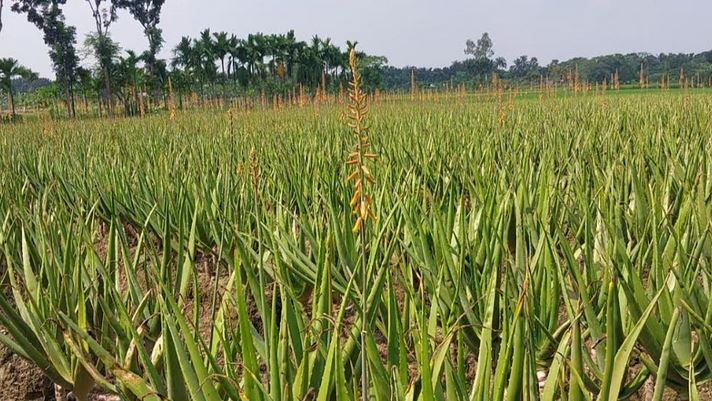News Flash

By Farazi Ahmed Rafique Babon
NATORE, Oct 21, 2025 (BSS) - The country’s only herbal village has now become a proud heritage of Natore.
Visitors come to see it almost every day and become amazed. The village alone produces about 15,000 tons of aloe vera annually, along with 140 other types of medicinal herbs including Shimul root and Ashwagandha.
The total market value of these herbal products is expected to be over Tk 100 crore.
The herbal village is spread across 15 cluster areas under Laxmipur-Kholabaria Union in Natore Sadar Upazila. Located along the main union road, the herbal fields create a picturesque landscape.
According to local sources, in the year 1995, Afaz Pagla of Kholabaria began cultivating medicinal plants for his own herbal medicine practice.
The initiative gradually spread across the entire village, and eventually throughout the union.
Now, medicinal plants can be seen not only on croplands but also around homesteads, along roadsides, and by riverbanks. Among all, the aloe vera plants stand out as the most visually appealing.
According to the Natore Sadar Upazila Agriculture Office, 140 species of medicinal plants grow in Laxmipur-Kholabaria. Notable among them are aloe vera, shimul root, ashwagandha, mishri dana, beetroot, roselle, and shatamul. Out of 155 hectares of cultivated land, 70 hectares are dedicated to aloe vera farming.
From 50 hectares of land, about 1,200 tons of shimul root are harvested annually. Beetroot cultivation in 12 hectares of land while 5 hectares of mishri dana yield around 50 tons of herbs. Around 12 tons of ashwagandha are grown on 10 hectares of land. Nearly 2,000 farmers in the union are involved in medicinal plant cultivation.
Typically, after the monsoon ends—from November to February—farmers plant about 10,000 aloe vera saplings per bigha. Leaves can be harvested for the next two years. With proper irrigation, harvesting starts within three months of planting.
Cultivation, care, and irrigation require about 100 laborers per field throughout the year. Besides organic fertilizers, farmers use urea, TSP, MOP, gypsum, zinc, and boric acid. To prevent black spots on the leaves, lime is also used.
To control leaf-boring insects and other pests, both farmers and the agriculture department have recently started using Trichoderma and pheromone traps. The average yield per bigha is about 30 tons of aloe vera.
Farmer Md. Haris said, “This is the new planting season for aloe vera. Due to the prolonged monsoon this year, many plants suffered from rot, and we faced losses. Seedling prices are also higher. But with careful cultivation, the second-year harvest will bring profit.”
However, there are no aloe vera processing facilities in the area. Farmers must send freshly harvested leaves directly to their destinations—mainly pharmaceutical and cosmetic companies, as well as juice manufacturers. Hamdard and a few other pharmaceutical companies buy the leaves, while Taiwan Hsin Lin Enterprises, a foreign-owned juice producer in Valuka, Mymensingh, is a major buyer.
Every day, several truckloads of aloe vera are shipped to Dhaka and other regions.
Dried and processed herbs are used to make various herbal medicines, which are marketed through around 100 herbal businesses across four trading centers in the area.
Kazi Kabir Ahmed, proprietor of Bonolota Bheshoj Bhandar at Amirganj Bazar, said, “More than a hundred types of herbs are sold in this market. Wholesalers from different districts come to buy the herbs. Our average daily sales reach around Taka 80,000.”
Herbal grower and cooperative leader Md. Zainal Abedin said, “If a cold storage facility and a cosmetic manufacturing plant—for items like soap and shampoo—are set up here, we will get benefitted greatly.”
Md. Shahidul Islam, president of the Kholabaria Hajiganj Bazar Herbal Production and Marketing Cooperative Society, demanded establishment of a medicinal plant research center under the forest research institute in the village.
“This would help us maintain the quality and standard of our products and attract pharmaceutical and cosmetic industries, further enriching our herbal village,” he said.
Natore Sadar Upazila Agriculture Officer Nilima Jahan said, “Around 10,000 people are directly or indirectly involved in herbal cultivation, processing, marketing, or agricultural labor in the village. The scope of the herbal village is expanding steadily.”
Md. Habibul Islam Khan, Deputy Director of the Department of Agricultural Extension, Natore, told BSS, “If a cold storage, processing center, and research institute can be set up in the herbal village, farmers will greatly benefit, and the country’s only herbal village will become even more prosperous.”